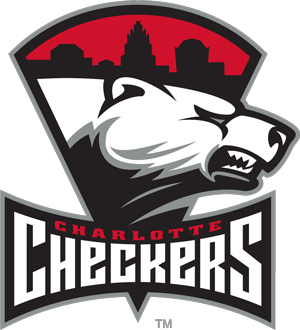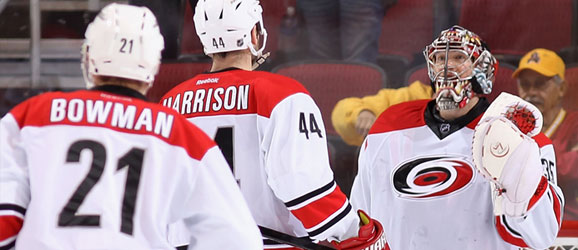Four players who spent significant time with Charlotte in recent seasons – forwards Drayson Bowman and Riley Nash, defenseman Brett Bellemore and goalie Justin Peters – have been with the Hurricanes for most, if not all, of the season, seemingly cementing themselves as full-time NHL players. Others, like defensemen Justin Faulk, who recently made the U.S. Olympic team, and Ryan Murphy played their games with the Checkers but had the pedigree that was always going to make their stays quite short.
To date, the former group is an example of how things are supposed to work – taking players who were productive in juniors and in college and slowly molding them into those capable of playing at the highest level.
“From a young age, they made a commitment to being professional hockey players,” said Checkers coach Jeff Daniels, who is in his sixth season as head coach of the Hurricanes’ AHL affiliate. “They deserve all the credit because they’re doing all the hard work. Some guys have taken a little longer than others to make the jump, but it starts down here. You have to prove yourself, and those guys have.”
For players like Bowman, Nash, Bellemore and Peters, it’s a message that required some reinforcement, which the organization’s player development staff was happy to provide. Daniels ended up playing a total of 425 NHL games, but not until he had played 515 in the IHL and AHL. Assistant coach Geordie Kinnear played 461 games in those leagues before getting his first taste of the NHL in year seven.
Cory Stillman, who, along with Glen Wesley (defensemen) and Greg Stefan (goalies), spends significant time with the Checkers during the season, can also pass along lessons from personal experience.
“I was a high draft pick to the NHL (sixth overall in 1992), got sent back to junior and played two years in the minors,” said Stillman, a point-per-game player on the Hurricanes’ 2006 Stanley Cup team. “For being a high pick, I took the long way in order to play on the fourth line. Fifteen years later, I was on the first line.”
Why do some players take longer to make it than others?
“The biggest thing is understanding that your role might change when you get up top,” said Stillman, who is in his second year as the organization’s director of forward development following his retirement as a player in 2011. “(In the AHL), we know what you do well. We know that you can score. We know you can slow the play down. In order to make that next jump, you’ve got to bring another element to your game.”
In addition to the aforementioned group of players that seem to have “graduated,” so to speak, Stillman referenced Zach Boychuk as an example of how players learn over time. In his fifth professional season, Boychuk, a first-round pick in 2008, has, at age 24, rebuilt his stature as an NHL prospect with strong performances in Charlotte, leading to his current stint with Carolina.
“It’s about being in people’s faces,” said Stillman. “It’s not about getting his power-play rush down the wing which he does all the time in Charlotte. It would happen every game and he’s really good at that. He’s not seeing a lot of power-play time (in Carolina), but he’s creating havoc. He’s skating, he’s stopping and starting and he’s getting on bodies. It doesn’t mean you have to run over and kill people, but at least be seen and be noticed. Be a hard player to play against.
“We’re quick to judge people, and with Zach playing on two different teams and coming back last season, you get a taste of it and know you can play, and now as an individual you have to look and figure out what I have to do to make that jump in order to stay in the NHL.”
A look at each of the former Checkers who have spent this season in Carolina and how they got to that point over time:
DRAYSON BOWMAN
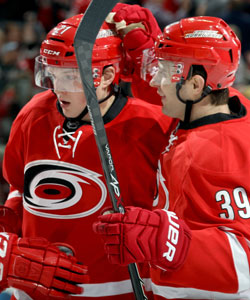
To Stillman’s point about finding your role, there’s nothing entirely wrong with that.
“Just because you’re a big goal scorer in junior doesn’t mean you’re a big goal scorer at the next level,” said Daniels. “He accepted what he was going to be and took a better understanding of being a good, strong, two-way forward that can kill penalties and chip in goals here and there. He’s an NHL skater, he’s a smart player and it just took him some time to figure that two-way game out to the point right now where Kirk (Muller) trusts him in a lot of different situations.”
Bowman still holds the Checkers’ franchise record for longest goal streak, having scored in eight consecutive games during last season’s lockout. That alone is more than the six goals he’s scored in 77 NHL games as a full-time player for Carolina ever since that work stoppage ended.
“If you get a chance you take advantage of it, and that’s what he’s done,” said Stillman. “He’s down here and scores goals, but now he’s up there in a fourth-line role, checks and kills penalties. It’s a matter of finding your game at the next level.”
RILEY NASH
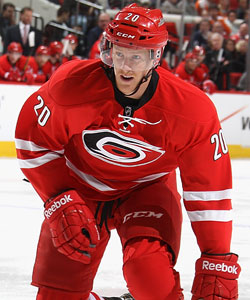
“That was the best game I’ve ever seen him play,” said Daniels of Nash, who scored two goals in Texas on March 23. “Once you get a taste of the next level you want to stay there.
“His first year (in Charlotte) was a real learning year for him, just the grind of the schedule and the pace of the game coming in from college. He kind of took baby steps his first year and each year got better and better until last year his confidence was where it needed to be. You saw some of the skill he had that made him a first-round draft pick. He’s a very smart hockey player.”
Nash has 10 points in 36 games as Carolina’s third-line center this season. When he suffered an injury last week, that meant a player coming up from Charlotte to replace him, instead of the other way around.
BRETT BELLEMORE
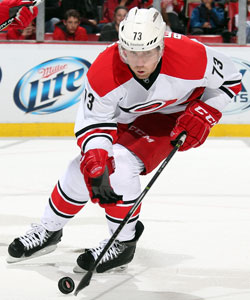
Bellemore, now 25, played most of four AHL seasons before playing a single NHL game. That game came last season, and only when a number of his teammates had preceded him over the course of a string of injuries that hit Carolina’s defense. Like Nash, except for returning to Charlotte when Carolina’s season was all but over, he hasn’t come back.
“For myself and Geordie, he’s a guy that we can always use as a reference for sticking with it,” said Daniels. “When we have one-on-one meetings with players, we always use Belly’s name as saying, ‘Listen. Never stop believing. Keep believing in your dream, because it might not happen for two, three or four years down the road, but when it does, you’ll appreciate it a lot more.’”
“He just stuck to it and there was a lot of up and down, but the progression was always elevated,” said Kinnear. “He learned to be mentally tough, which is paying dividends for him now at the next level. I want to teach players down here so that they’re not tweeners – so that they go up and be successful right away and can read and play the game at a high level. My philosophy is that when you go up, I want you to stay up. I don’t want you coming up and down.”
Bellemore, a sixth-round pick in 2007, is the least-heralded prospect of the group – a longshot who got by with work and grit rather than natural skill. As it just so happened, that ended up being the kind of player Carolina needed.
“As coaches, we really appreciate him for what he did,” said Daniels. “Some nights it doesn’t look pretty, but the job always gets done.”
JUSTIN PETERS
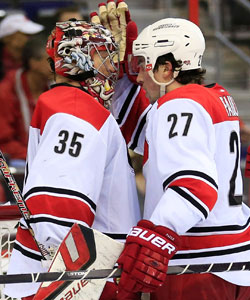
This summer, it was the signing of Khudobin that tagged Peters for a return to Charlotte, where he had put together what was statistically the best-ever season by a Checkers goalie one year earlier. If he was disappointed about not getting more of a chance to prove himself – he didn’t even get an NHL exhibition game last fall – it didn’t show.
“He was unbelievable, right from day one,” said Daniels. “When he got sent down he called me right away and let me know that he was coming and wanted to get settled right away. His focus was on the team down here and being the goalie he can be.”
Peters only played one game for Charlotte – a season-opening win in Oklahoma City – before an injury to Khudobin put him back in the NHL. With both Khudobin and Ward out of the lineup at one point, Peters more than held his own as the Hurricanes’ starter, raising his profile to the level that the team won’t risk putting him on waivers by sending him back to Charlotte.
“He’s always been a great competitor,” said Daniels. “Nobody out-works Petey with the way he battles in the net, and that really rubs off on the players in front of him because they want to work so hard for him.
“From my time with him, he’s so much mentally stronger. Nothing bothers him. He’s just focused and he doesn’t get wrapped up in the after-the-whistle stuff. His focus is on doing his job and he’s obviously been great for Carolina this year.”
Those four players have set the first real-life examples of players who have made it after paying their dues, valuable reinforcement to current Checkers that have either been in the AHL for years or have just turned pro and are already starting to feel the anxiety of time ticking away.
“Some guys are going to come right out of junior and come right to the NHL, some guys are going to take a year and some guys are going to take two or three years,” said Stillman. “As an organization and as people, don’t write them off and say they can’t play. You never know. Some guys don’t make it to the NHL until they’re 26 or 27 and then they play another 10 years.
“Those guys are up there now and you’re going to see more come through here. That’s what this is. It’s a development league.”


